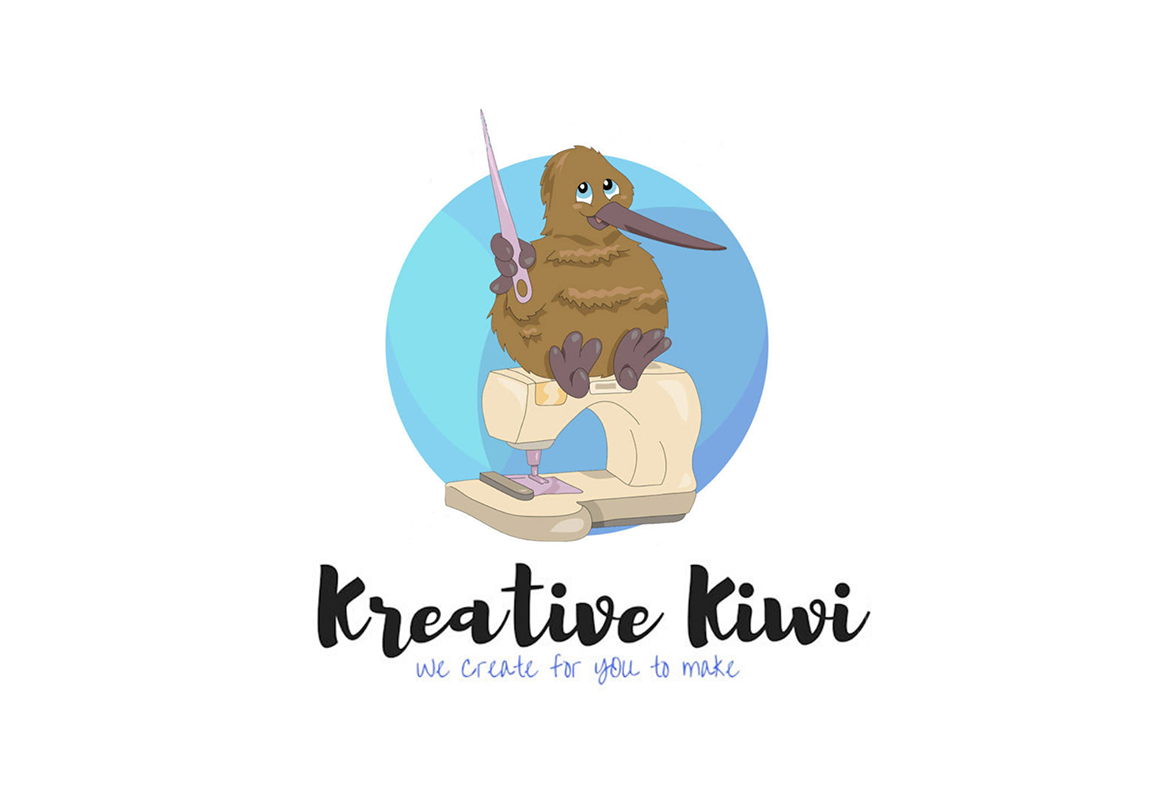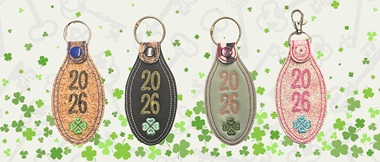
Whimsical 3D Santa door hanging
The holidays are coming! If you celebrate Christmas, what says happy holidays more than embroidering your own supersize Santa?
We've teamed up with Heather Duff, from Kreative Kiwi, to bring you this fun supersize in-the-hoop Santa embroidery project.
Using this free pattern’s* joining in-the-hoop method, you can easily make a design larger than your hoop, with no additional sewing required.
The smallest hoop that you can complete this project on is a 180 x 130mm hoop. And the largest is on our super-size XP hoop, 408 x 272mm :)



*This pattern is available as a free download until 31 January 2023.
After 1 February 2023, you will need to buy the pattern from Kreative Kiwi. Download and make it now!
Finished size


Materials
- Fabric in different colours, you can go with a traditional red and white scheme, or mix it up to fit your décor (see our Disco Santa at the end of the article!). Like all appliqué, this project can be made from scraps – the biggest piece of material you will need is the size of your hoop plus 2.5cm.*
- Plain backing fabric – if you’re making Santa as a hanging where only one side is seen. Not required if you’re stitching Santa onto something else.
- 8 x layers of fabric-type water-soluble stabiliser (you will use two per hooping) – do not use the film type, as it is unsuitable for this project.
- Thin batting
- Stiff felt or bag backing – if making one-sided
- Water-soluble topper – if using faux fur for the trim
- Neutral embroidery thread
- Matching embroidery thread
- Metallic embroidery thread
- Clear monofilament thread (optional)
- Matching bobbin thread – only required for a two-sided Santa
- Masking tape
- Pen
- Small piece of ribbon, if you’re planning to hang your Santa up
*For full fabric sizes for your particular hoop size, we’ve created a table which you can download here. Make sure you double the fabric requirements if you’re making a two-sided Santa.
Equipment
- Embroidery machine – minimum 180 x 130 mm size hoop
- Scissors – including a small, curved pair
- T-head pins
- Standard pins
- Embroidery needles
How to
Before you start
- Download all files. Insert your largest hoop and make sure your hoop is large enough to make the completed design (we suggest you open file 2 as a check).
- Starting with file 1, stitch the sections in order, or the pattern won’t work.
- Download, transfer, and work on one pattern at a time.
- Use T-head pins at hoop edges to ensure no movement in your stabiliser. Watch our video (below) to see correct pinning method.
- You will need to alter the height of your embroidery at different points of the stitch out to accommodate the material you are using. Foot height and sequence will depend on the fabric used for this pattern.
- If you are using the super-size XP hoop, then your fabric stabiliser will probably not be wide enough. Sew two widths of your stabiliser together with an overlap.
A word of warning: if you are making a double-sided Santa, please take care not to use too thick fabrics as it will be difficult to stitch. Especially for the fur beard - we recommend fur on the front side, and a thinner fabric or felt for the back side. Slow down the speed of your embroidery and carefully watch the progress especially at thicker intersections.


Step 1
As this is a complicated pattern, please read through every step first.
Step 2
Then, watch our useful video below and refer to it as you make the project. Or watch the full step-by-step video here.
Step 3 – hooping 1, file 1, Santa’s legs
Hoop two layers of fabric-type water-soluble stabiliser. Place your hoop in the embroidery machine.Step 4
Stitch Colour 1 to stitch the placement line on the stabiliser. Use your neutral thread for all placement lines throughout this project.Step 5
Place batting over the guideline. Use tape to keep in place.
Step 6
Stitch Colour 2 to attach the batting. Cut away any excess batting. There will be a gap between the first outline and the batting. This is correct, it keeps the batting away from the seams.


Step 7
Optional: if this is a two-sided or one-sided hanging Santa. Skip if you’re adding this Santa to a quilt etc.
Tape your backing fabric (covers entire back of design) on the back of the hoop, right side up. Stitch Colour 3 to attach the backing fabric.

Step 8
Now we’re placing individual fabrics. Place leg fabric over the guideline, using tape to keep in place. Remember to add on the back side if you’re making a two-sided Santa. Remember to switch your bobbin thread to match your top thread if you’re making this two-sided.

Step 9
Stitch Colour 4 to attach. Then remove tape and trim excess fabric. Remember to trim the back side if you’re sewing a two-sided Santa.
Step 10
Now place the fabric you’re using for Santa’s boots and stitch Colour 5. Cut excess fabric.


Step 11
Add the fabric you’re using for the boot trim. Stitch Colour 6 and cut away excess.
Tip: if you want to use a faux fur to for the trim, add plastic water-soluble film over the trim. It holds down the fur nap, making it easier for the machine to stitch and ensuring a neat stitch out.



Step 12
Stitch Colour 7, which is a zig-zag stitch around the design.
Tip: To minimise stop/starts and excess tie offs, we used one thread colour for this. If you’re worried about thread contrast, use a clear monofilament thread here. If you don’t have clear, you could use white or a neutral colour.
Step 13
Complete the embroidery detail. Remember to use matching bobbins for each separate colour if you’re making this reversable.
- Colour 8 – leg detail and satin stitch edge.
- Colour 9 – boot satin edge stitch.
- Colour 10 – trim satin stitch edge.
Step 14
Remove the design from the hoop and cut away excess stabiliser. In areas of the design with satin stitches, cut as close to the edge as you can without cutting the stitches. Where there is a raw edge (ie. at the top of the legs), cut as close as you can to the outline stitches. This will help when you join the designs.
Step 15 – hooping 2, Santa’s body
Hoop another two layers of stabiliser ready to make the next pattern part.Step 16
Stitch out Colour 1, which is the placement line. You’ll see three small marks on the lower edge of the outline. These are guidelines for the leg placement. Use a pen to extend these lines to make it easier when you join the pieces together.
Step 17
Place the batting over the guideline, tape in place and stitch Colour 2. Cut away excess batting.Step 18
Optional for hanging or double-sided Santa – tape backing fabric to back of hoop and stitch Colour 3. Trim excess.Step 19
Like the previous piece, we’re now going to sew each colour of the pattern in order.1. Body fabric – stitch Colour 4.
2. Trim fabric – stitch Colour 5.
After each fabric/stitch colour trim the excess.
Step 20
Stitch Colour 6 – zigzags round the raw edges. Use clear monofilament (or white) here if you are using it. STOP the machine when you reach the pen lines you drew to mark the legs.Step 21
Place your leg pieces inside the extended pen guidelines marked on your stabiliser. Match the stitch lines on the top of the legs against the bottom of the Santa suit. There will be a slight overlap. Make sure you put your legs on the right way! Tape and pin in place outside of the stitch lines.
Step 22
Continue stitching Colour 6 to join the left knee.Step 23
Stitch Colour 7 to join the legs on. Make sure the zigzag catches both side of the fabric. If you’re unhappy with your result, repeat this step.Step 24
Stitch Colour 8, which completes the zigzag of the raw edges.Step 25
Complete the embroidery detail. Use matching bobbins if making reversable.1. Colour 9 – suit inner detail and satin stitch edge.
2. Colour 10 – suit trim satin stitch edge.
3. Colour 11 – suit buttons.
Step 26
Remove the design from the hoop and cut away excess stabiliser. In areas of the design with satin stitches, cut as close to the edge as you can without cutting the stitches. Where there is a raw edge cut as close as you can to the outline stitches. This will help when you join the designs. Take care not to cut the legs off!
Step 27 – hooping 3, Santa’s head
Hoop two layers of stabiliser for hooping 3 and stitch Colour 1 placement line.Step 28
Optional – if you’re including a hanging loop, fold and attach at the top of the hat outline where there is a stitch line marker. Make sure the tape is outside the stitch edge.
Step 29
As previously we’re going to stitch each colour and layer, trimming the excess each time.
- Batting – Colour 2.
- Optional, backing – Colour 3.
- Hat fabric – Colour 4.
- Nose fabric – Colour 5.
- Beard fabric – Colour 6.
- Zigzags – Colour 7. This will stop where you will join the body to the beard (see image).
Step 30
Like before we're going to match the pieces of the body to the head at a little bit of an angle. Match the stitch lines on the design in the hoop against the completed parts. You will have a small overlap. Tape and pin in place outside of stitch lines.
Step 31
Stitch Colour 8 to join your head to your body. Make sure the zigzag catches both sides of the fabric. Repeat if necessary.Step 32
Complete the embroidery detail. Remember your bobbin thread!
- Colour 9 – hat detail and stain stitch edge.
- Colour 10 – nose satin stitch edge.
- Colour 11 – beard satin stitch.
Step 33
Remove from the hoop and cut excess. Be careful not to cut through your hanging loop if you’re using one. Follow previous instructions for satin stitches and raw edges.
Step 34 – hooping 4, Santa’s arm and sack (last hoop)
Prepare your hoop with two layers of stabiliser and stitch Colour 1 placement line.
Step 35
As before we’re going to add each of the layers for this design. Cut excess after each stitch out.
- Batting – Colour 2.
- Optional, backing – Colour 3.
- Sack – Colour 4.
- Suit (arm) – Colour 5.
- Glove – Colour 6.
- Glove trim – Colour 7.
- Zigzag – Colour 8.
Step 36
Line up the rest of your Santa, tape and pin in place outside of stitch lines. Stitch Colour 9 to join. Make sure you catch both sides of the fabric in the zigzag.
Step 37
Complete embroidery detailing.
- Colour 10 – sack and satin stitch edge.
- Colour 11 – suit (arm) satin stitch edge.
- Colour 12 – glove satin stitch.
- Colour 13 – glove trim satin stitch.
- Colour 14 – snowflake design on sack.
Step 38
Remove design from hoop and cutaway excess stabiliser from edges. Use hot water and a cotton bud to remove all traces of stabiliser. Remove the plastic water-soluble film stabiliser using your small scissors and pulling off gently.




Design and copyright: Heather Duff, Kreative Kiwi




